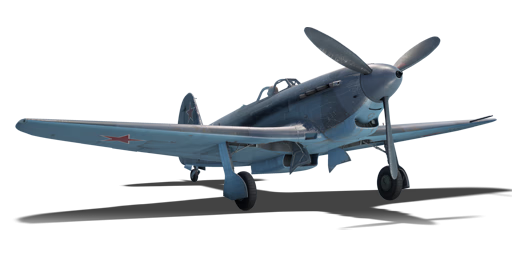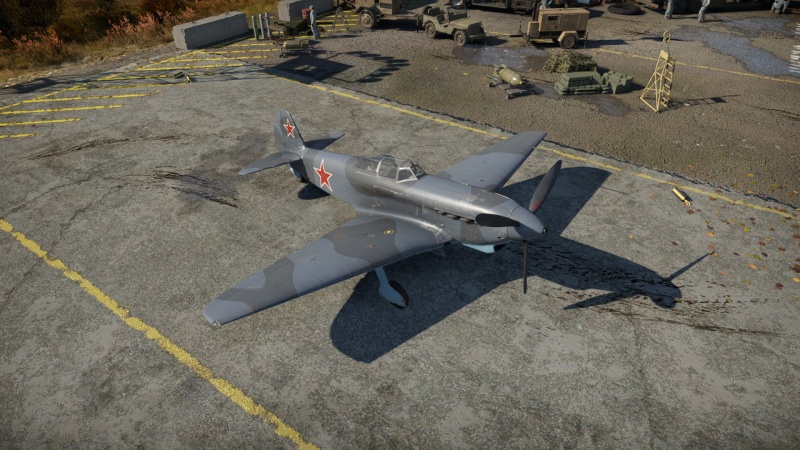Difference between revisions of "Yak-9B"
(→Description) |
m (→History: Added history) |
||
| (2 intermediate revisions by 2 users not shown) | |||
| Line 31: | Line 31: | ||
|- | |- | ||
! Stock | ! Stock | ||
| − | | 573 || 558 || rowspan="2" | {{Specs|ceiling}} || 21.8 || 22. | + | | 573 || 558 || rowspan="2" | {{Specs|ceiling}} || 21.8 || 22.5 || 13.6 || 13.6 || rowspan="2" | 500 |
|- | |- | ||
! Upgraded | ! Upgraded | ||
| − | | | + | | 609 || 591 || 20.2 || 21.0 || 18.4 || 16.0 |
|- | |- | ||
|} | |} | ||
| Line 152: | Line 152: | ||
== History == | == History == | ||
| − | + | An experimental fighter-bomber version of the Yak-9D with four vertical tube bomb bays behind the cockpit. The bomb bay had a capacity of up to 4 x 100 kg (220 lb) FAB-100 bombs or 4 PTAB cassettes with 32 x 1.5 kg (3.3 lb) bomblets each. The typical loadout was 200 kg (440 lb) of bombs.<ref>https://en.wikipedia.org/wiki/Yakovlev_Yak-9</ref> The Yak-9B was evaluated by the 30th Fighter Division from 18 December 1944 until 20 February 1945, with the trials proving unsuccessful. Bomb release could be achieved at dive angles of less than 45 degrees, but a 400 kg bomb load could not be released this way, which limited the ability to take advantage of the plane's total bomb capacity. Poor handling with a full bomb load and full fuel load, combined with a lack of special aiming equipment, limited the Yak-9B's combat usefulness.<ref>https://airpages.ru/eng/ru/yak9.shtml</ref> The Soviet Air Forces report back to the factory concluded: "Pilots did not want to fly the aircraft. The Chief Designer must redesign the aeroplane." The Yak-9B was not redesigned and never entered full production.<ref>https://www.airvectors.net/avyak1.html#m5</ref> | |
== Media == | == Media == | ||
| Line 179: | Line 179: | ||
* [[wt:en/devblog/current/817|[Devblog] Yak-9B and Hawker Hunter F.1]] | * [[wt:en/devblog/current/817|[Devblog] Yak-9B and Hawker Hunter F.1]] | ||
| − | * [https://forum.warthunder.com/index.php?/topic/272435-yakovlev-yak-9b/ Official data sheet - more details about the performance] | + | * [https://old-forum.warthunder.com/index.php?/topic/272435-yakovlev-yak-9b/ Official data sheet - more details about the performance] |
{{AirManufacturer Yakovlev}} | {{AirManufacturer Yakovlev}} | ||
{{USSR fighters}} | {{USSR fighters}} | ||
Latest revision as of 14:39, 3 September 2024
| This page is about the Soviet fighter Yak-9B. For other versions, see Yak-9 (Family). |
Contents
Description
The Yakovlev Yak-9B was a modified subvariant of the Yak-9D, which was the third variant of the Yak-9 fighter aircraft family. The Yak-9B was a fighter-bomber configuration of the Yak-9D (factory official designation Yak-9L) with four vertical tube bomb bays aft of the cockpit capable of carrying up to four 100 kg FAB-100 bombs or four PTAB cassettes with 32 1.5 kg bomblets each, though only 200 kg of weapons were normally carried. The Yak-9D was a longer-range variant of the standard Yak-9, with a fuel capacity increase from 440 to 650 litres and a maximum range of 1,400 km. Since the Soviet Army went on the offensive in 1943, covering operational advances from the air required an increased number of fighters. The Yak-9D underwent modifications to produce the Yak-9B, which could carry bombs, but this modification did not result in mass production as the Yak-9B armed with bombs had poor manoeuvrability, limiting its combat effectiveness against other fighters. Furthermore, the lack of bomb-aiming equipment made bomb targeting inaccurate.
Introduced in Update 1.53 "Firestorm", the Yak-9B is the only Yak fighter aircraft with an internal bomb bay. Players can experience the Yak-9B's unique design of being able to ground strike as well as compete for aerial supremacy against adversaries. This is very useful in ground realistic battle mode. Playstyles are identical to those of other Yak families, with the exception that manoeuvrability is slightly reduced when armed with bombs. It remains on the low-altitude spectrum for best performance, though the engines are slightly more powerful as compared to the Yak-1 variants.
General info
Flight performance
| Characteristics | Max Speed (km/h at 3,700 m) |
Max altitude (metres) |
Turn time (seconds) |
Rate of climb (metres/second) |
Take-off run (metres) | |||
|---|---|---|---|---|---|---|---|---|
| AB | RB | AB | RB | AB | RB | |||
| Stock | 573 | 558 | 8900 | 21.8 | 22.5 | 13.6 | 13.6 | 500 |
| Upgraded | 609 | 591 | 20.2 | 21.0 | 18.4 | 16.0 | ||
Details
| Features | ||||
|---|---|---|---|---|
| Combat flaps | Take-off flaps | Landing flaps | Air brakes | Arrestor gear |
| X | X | ✓ | X | X |
| Limits | ||||||
|---|---|---|---|---|---|---|
| Wings (km/h) | Gear (km/h) | Flaps (km/h) | Max Static G | |||
| Combat | Take-off | Landing | + | - | ||
| 683 | 320 | N/A | N/A | 280 | ~12 | ~9 |
| Optimal velocities (km/h) | |||
|---|---|---|---|
| Ailerons | Rudder | Elevators | Radiator |
| < 380 | < 420 | < 490 | > 340 |
Survivability and armour
The Yak-9B isn't the worst protected aircraft, but it isn't great either. It has some armour protection, and the fuel tanks are self-sealing. Most of the fuel tanks are located in the wings, and one is located beneath the pilot's seat in the fuselage, along with the oil cooler. You can not rely on the survivability of the Yak-9B, although it may save you on a rare occasion.
- 64 mm bulletproof glass - Windscreen
- 64 mm bulletproof glass - Behind pilot's head
- 8 mm steel - Behind pilot's seat
- Self-sealing fuel tanks
Modifications and economy
Armaments
Offensive armament
The Yak-9B is armed with:
- 1 x 20 mm ShVAK cannon, nose-mounted (120 rpg)
- 1 x 12.7 mm Berezin UB machine gun, nose-mounted (200 rpg)
Suspended armament
The Yak-9B can be outfitted with the following ordnance:
- Without load
- 2 x 100 kg FAB-100sv bombs (200 kg total)
- 3 x 100 kg FAB-100sv bombs (300 kg total)
- 4 x 100 kg FAB-100sv bombs (400 kg total)
Usage in battles
Describe the tactics of playing in the aircraft, the features of using aircraft in a team and advice on tactics. Refrain from creating a "guide" - do not impose a single point of view, but instead, give the reader food for thought. Examine the most dangerous enemies and give recommendations on fighting them. If necessary, note the specifics of the game in different modes (AB, RB, SB).
Manual Engine Control
| MEC elements | ||||||
|---|---|---|---|---|---|---|
| Mixer | Pitch | Radiator | Supercharger | Turbocharger | ||
| Oil | Water | Type | ||||
| Controllable | Controllable Not auto controlled |
Controllable Not auto controlled |
Controllable Not auto controlled |
Separate | Controllable 2 gears |
Not controllable |
Pros and cons
Pros:
- Accurate centre-mounted armament
- Excellent performance at altitudes below 3,000 m
- Experience with the Yak-1 series and standard Yak-9 carry over to this plane
- Slightly better engine than the Yak-1 series
- Internal bomb bay reduces drag when carrying bombs over being carried externally
Cons:
- Low ammunition count, requires accurate firing to damage enemy planes
- Low maximum dive speed
- Performance decreases at altitudes above 3,000 m
- Engine overheats at full throttle
- No WEP in Realistic and Simulator battles
History
An experimental fighter-bomber version of the Yak-9D with four vertical tube bomb bays behind the cockpit. The bomb bay had a capacity of up to 4 x 100 kg (220 lb) FAB-100 bombs or 4 PTAB cassettes with 32 x 1.5 kg (3.3 lb) bomblets each. The typical loadout was 200 kg (440 lb) of bombs.[1] The Yak-9B was evaluated by the 30th Fighter Division from 18 December 1944 until 20 February 1945, with the trials proving unsuccessful. Bomb release could be achieved at dive angles of less than 45 degrees, but a 400 kg bomb load could not be released this way, which limited the ability to take advantage of the plane's total bomb capacity. Poor handling with a full bomb load and full fuel load, combined with a lack of special aiming equipment, limited the Yak-9B's combat usefulness.[2] The Soviet Air Forces report back to the factory concluded: "Pilots did not want to fly the aircraft. The Chief Designer must redesign the aeroplane." The Yak-9B was not redesigned and never entered full production.[3]
Media
- Skins
- Videos
See also
- Related development
External links
| A.S. Yakovlev Design Bureau (Яковлев Опытное конструкторское бюро) | |
|---|---|
| Fighters | |
| Yak-1 | Yak-1 · Yak-1B |
| Yak-3 | Yak-3 · Eremin's Yak-3(e) · Yak-3 (VK-107) · Yak-3P · Yak-3T · Yak-3U |
| Yak-7 | Yak-7B |
| Yak-9 | Yak-9 · Yak-9B · Yak-9K · Golovachev's Yak-9M · Yak-9P · Yak-9T · Yak-9U · Yak-9UT |
| Twin-engine fighters | I-29 |
| Jet fighters | |
| Yak-15 | Yak-15P · Yak-15 |
| Yak-17 | Yak-17 |
| Yak-23 | Yak-23 |
| Yak-30 | Yak-30D |
| Yak-141 | Yak-141 |
| Strike aircraft | |
| Yak-2 | Yak-2 KABB |
| Yak-38 | Yak-38 · Yak-38M |
| Bombers | Yak-4 |
| Jet bombers | Yak-28B |
| Foreign use | ▄Yak-3 · Challe's ▄Yak-9T · ◔Yak-9P |
| Captured | ▀Yak-1B |
| USSR fighters | |
|---|---|
| I-15 | I-15 WR · I-15 M-22 · I-15 M-25 · I-15bis · Krasnolutsky's I-15bis |
| I-153 M-62 · Zhukovsky's I-153-M62 · I-153P | |
| I-16 | I-16 type 5 · I-16 type 10 · I-16 type 18 · I-16 type 24 · I-16 type 27 · I-16 type 28 · I-180S |
| I-29 | I-29 |
| I-185 | I-185 (M-71) · I-185 (M-82) |
| I-225 | I-225 |
| ITP | ITP (M-1) |
| MiG-3 | MiG-3-15 · MiG-3-15 (BK) · MiG-3-34 |
| LaGG | I-301 · LaGG-3-4 · LaGG-3-8 · LaGG-3-11 · LaGG-3-23 · LaGG-3-34 · LaGG-3-35 · LaGG-3-66 |
| La | La-5 · La-5F · La-5FN · La-7 · Dolgushin's La-7 · La-7B-20 · La-9 · La-11 |
| Yak-1/7 | Yak-1 · Yak-1B · Yak-7B |
| Yak-3 | Yak-3 · Eremin's Yak-3(e) · Yak-3P · Yak-3T · Yak-3U · Yak-3 (VK-107) |
| Yak-9 | Yak-9 · Yak-9B · Golovachev's Yak-9M · Yak-9T · Yak-9K · Yak-9U · Yak-9UT · Yak-9P |
| Other countries | ▂P-40E-1 · ▂P-47D-27 · ▂Hurricane Mk IIB · ▂Fw 190 D-9 · ▂Spitfire Mk IXc |
| P-39 | ▂P-39K-1 · ▂Pokryshkin's P-39N-0 · ▂P-39Q-15 |
| P-63 | ▂P-63A-5 · ▂P-63A-10 · ▂P-63C-5 |





